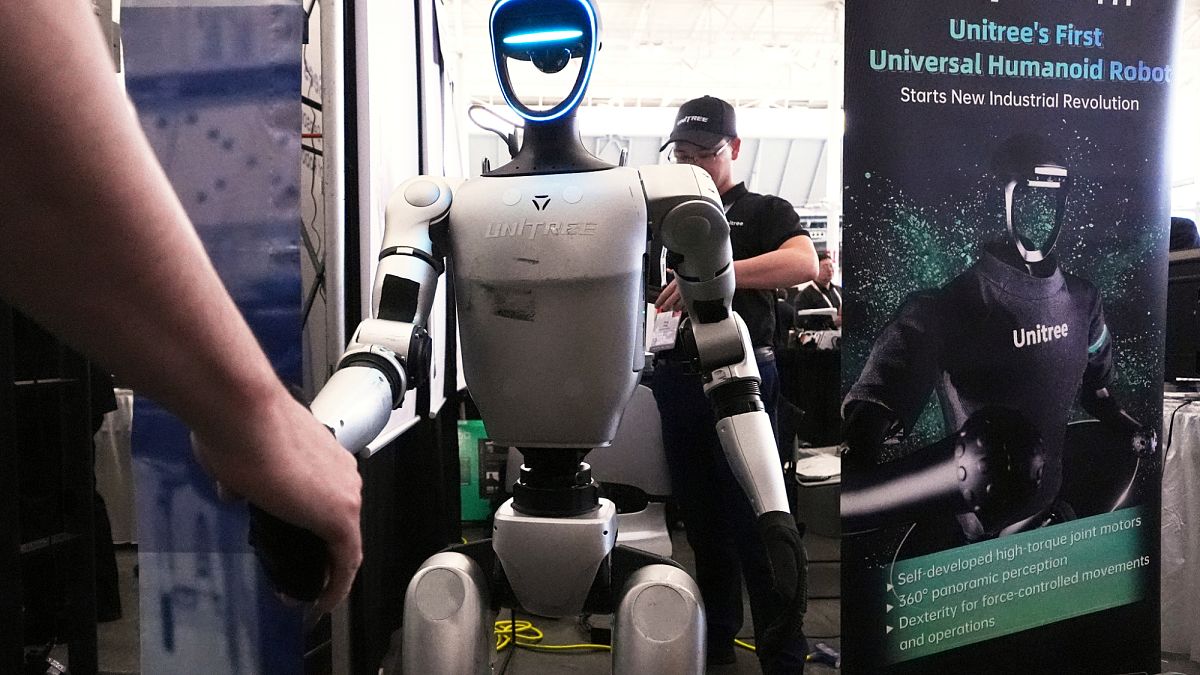Tariffs weren’t on the agenda of this week’s Robotics Summit in Boston, United States, where thousands of tech industry workers mingled with humanoid and other robot varieties and talked about how to build and sell a new generation of increasingly autonomous machines.
Not on the official agenda, at least.
“Jump up to the microphones,” said keynote speaker Aaron Saunders, chief technology officer (CTO) of Boston Dynamics, inviting a standing-room-only crowd to ask him questions. “And I’m the CTO, so don’t ask me about tariffs”.
The crowd laughed and complied.
But as they streamed onto the show floor at Boston’s convention centre, greeted by a remote-controlled humanoid made by Chinese company Unitree, it was hard to ignore the shadow of US President Donald Trump’s far-reaching global tariffs and retaliatory measures from his biggest target, China.
Tariffs are the “No. 1 topic that we’re discussing in the hallways and at the water cooler with people that I’ve known for a long time,” said event organiser Steve Crowe, chair of the annual Robotics Summit & Expo.
“I think it’s definitely top of mind, because there’s so much uncertainty about what is going to come”.
Scarcity of rare earth magnets
That concern is rooted in a robot’s complex anatomy of motors and actuators to move its limbs, computers to power its artificial intelligence (AI), and sensing devices to help it react to its surroundings.
Sensors, semiconductors, batteries, and rare earth magnets are among the array of components most sensitive to global trade disputes.
Tesla CEO and billionaire Trump adviser Elon Musk warned investors last week that China’s countermeasures restricting shipments of rare earth magnets will delay Tesla’s development of its Optimus humanoid robots.
At the summit on Wednesday and Thursday, some humanoid makers were looking at a potential bright side to the geopolitical shifts as American businesses look harder for domestic supplies of parts and the development of US-based robots that can automate factories and warehouses.
“It’s added some inconveniences to our own supply chain. But it’s also opened up opportunities,” said Pras Velagapudi, CTO at Oregon-based Agility Robotics, in an interview.
The company is starting to deploy its humanoid robot, called Digit, at a US plant run by German manufacturer Schaeffler, a maker of ball bearings and other components key to the auto industry.
Al Makke, a director of engineering for Schaeffler’s chassis systems, said tariffs could push many companies toward onshoring production of a variety of items in the US.
“And if that does happen, then local companies have to deal with high labour costs and a shortage of labour, and so automation gets pushed further,” Makke said. “And one of those faces of automation is humanoids”.
a more familiar pack of its four-legged Spot robots contained in a pen on the show floor.
Supply chain uncertainty
Most of the big industrial robots employed in the US are used to help make cars, and are imported from countries such as Japan, Germany, or South Korea.
Automakers in the US installed 9.6 per cent more robots in their plants than a year before, according to new data from the International Federation of Robotics, a trade group.
For now, humanoids are still a niche but one that invites intense curiosity, in part thanks to popular science fiction.
Saunders, of Hyundai-owned Boston Dynamics, presented an update Wednesday on the development of its Atlas humanoid robot, but didn’t bring a physical prototype, instead showing off
The sole humanoid at the conference was Unitree’s G1. Marketed for $16,000 and remote-controlled by an employee standing nearby, the robot fluidly shook hands, waved back at people, and walked around the show floor, but it won’t be moving totes or working in a factory anytime soon.
Its main customers outside China are academic researchers and some social media influencers, and Trump’s current tariffs totalling 145 per cent on China would raise its cost to American buyers to roughly $40,000 (€35,000), said Tony Yang, a Unitree vice president of business development who manages its North American sales.
Nevertheless, Unitree’s strategy to rapidly develop its hardware and software is a long-term one.
“It’s still a very narrow market, but I think there’s still a huge potential market on the industry side, like for manufacturing and factory, and even home use,” Yang said.
At a full pickleball court on the show floor, some conference attendees took a break to grab a racket and swing at balls tossed by a wheeled robot. Asked to describe what’s inside the Tennibot robot, its maker also had tariffs on the mind.
“Injection molded parts, rivets, screws, nuts, wheels, motors, batteries,” said Haitham Eletrabi, co-founder and CEO of Tennibot, based in Auburn, Alabama.
“The supply chain gets very complex. We get parts from all over the world. Tariffs are adding a lot of uncertainty”.
It’s not just the US-China trade rivalry weighing on some attendees. Francesca Torsiello, of the recruitment firm Adapt Talent, said she’s also hearing more wariness from Canadian robotics and engineering candidates about taking jobs in the US amid a tense political environment.
“In the past, people in Canada found it attractive to come and work for US companies; right now, they’re being very hesitant,” Torsiello said.

